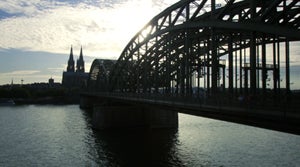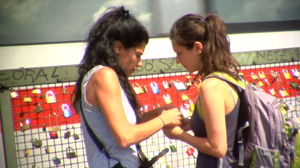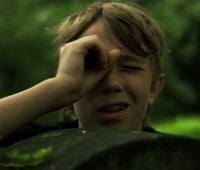Back in July 2010, I posted a blog about lecturing to a group of eager film students in Cologne, Germany, at the Internationale Filmschule (IFS). We were doing a one week academic seminar in and around Menschen am Sonntag/People on Sunday (1929), the seminal Weimar Republic film, directed by Robert Siodmak and Edgar G. Ulmer, with the participation of Curt Siodmak and Fred Zinnemann, all of them destined to influence American cinema in the following decades.

After the seminar, organized by Prof. Gundolf Freyermuth, Prof. Lisa Gotto and myself, our five German film students (from the IFS) and five American film students from UCLA divided up into four production teams and spent the next five weeks making short films, which were to be a portrait of Cologne in 2010, the way People was a portrait of Berlin in 1929. Now, sixteen months later, People on Sunday 2010, an omnibus film, had its premiere last Sunday at the Goethe Institute, Los Angeles. The film screened again on Tuesday at UCLA’s School of Theater, Film and Television. I saw it twice.
Spending time in Cologne in 2010 was both a new experience and an intensely personal trip into my own past, both alien and familiar. I’m an American, but Cologne is my mother’s birthplace, the way Prague is my father’s. I was born in a small town, not more than 40 miles from Cologne. I remember seeing Cologne from a train when I was 11, while visiting Germany for the first time: there were still many signs of the war, which had destroyed the city almost as badly as Dresden. When my family moved to Germany two years later, we regularly drove to Cologne to celebrate New Year’s Eve and “Karnival” with two of my mom’s old school friends. The mother of Grete Wehmeyer was an old Communist and had a salon on Sundays, where I got my first political education, listening to endless debates about why the Germans had allowed the Nazis to commit the Holocaust.
In Cologne for the seminar, I watched a World Cup Soccer match (a theme in the new film) with my oldest school friend. I also had dinner one night with a family friend who I literally shared a crib with. We talked about my mom, who died 30 years ago this last week and is buried in Bad Münstereifel, along with a host of other relatives. One of the women in the film says she is from Weilerswist, literally the next village over the hill.

Like its predecessor, People on Sunday 2010 begins an image from a train, not surprising, given the centrality of the Bahnhof right next to the Gothic Cathedral, the city’s most enduring and visible landmark. The station and its attendant railway bridge across the Rhine is a site of transitions, of cross-cultural communication, but also of promises of faithfulness against transitoriness, as signified in the Volk ritual of attaching locks to the bridge’s fence to seal a relationship. That ritual is performed in the film by a female couple, who rendezvous at the station. Another couple meets at the station and falls hesitantly in love over the course of the day. A young woman wants a threesome with two male friends, just for fun, but suffers coitus interuptus on all fronts. That story begins along the Rhine, a river embalmed in Germanic myths, including that of the “Lorelei,” just upstream from Cologne. A young artist has artist’s block and communication issues with his girlfriend.
All the stories in People 2010 are about the tenuousness of relationships, their fragility in an era of hooking up.
All the stories in People 2010 are about the tenuousness of relationships, their fragility in an era of hooking up. It was exactly that ability to portray realistically the gender politics of sex that made the original Menschen am Sonntag so modern for today’s student filmmakers. Not possible then, but now: two of the relationships in People 2010 involve interethnic couples without ever addressing the issue; a specific characteristic of this generation?
But there is something else that connects this motley crew of German and American filmmakers to Wilder, Siodmak and company, namely by making due with surprisingly little dialogue. Rather, the IFS/UCLA team has reinvigorated the silent camera’s ability to direct the look, to capture human emotion through vision. The many protagonists in the film look at each other, much more than they talk to each other. This is definitely not a French movie, but rather one that continually tries to build German-American bridges.

Like the original, so much of this film is about seeing, about perceiving your environment, wonderfully encapsulated in the scene of a child’s wish to see like a camera by creating a lens with thumb and index finger, and thereby innocently citing a visual convention of the silent era, while medieval trumpets provide the soundtrack.
My hats off to Becky Smith, the UCLA Professor guiding the production, and to the directors Nancy Mac Granaky-Quaye, Lucas Mireles, Johannes Sievert, and Iliana Sosa; also to the cinematographers Nina Frey, Jeanne Tyson, Leigh Underwood and Jens Nolte; production: Christopher Becker and Ryan Slatterly.






 Mobile Navigation
Mobile Navigation

